|
|
 |
Fiche d'espèce de Copépode |
|
|
Calanoida ( Ordre ) |
|
|
|
Clausocalanoidea ( Superfamille ) |
|
|
|
Scolecitrichidae ( Famille ) |
|
|
|
Scolecithrix ( Genre ) |
|
|
| |
Scolecithrix bradyi Giesbrecht, 1888 (F,M) | |
| | | | | | | Syn.: | Scolecithricella bradyi : A. Scott, 1909 (p.89, Rem.F,M); Pesta, 1920 (p.517); Mori, 1937 (1964) (p.51, figs.F); Wilson, 1942 a (p.207); Sewell, 1948 (p.346); C.B. Wilson, 1950 (p.333); Tanaka, 1953 (p.133); Chiba & al., 1957 (p.308); Fagetti, 1962 (p.25); Tanaka, 1962 (p.39, figs.F,M); Chen & Zhang, 1965 (p.61, figs.F,M); Furuhashi, 1966 a (p.295, vertical distribution in Kuroshio region, Table 9, 10); Herman & Mitchell, 1981 (p.739, Table 2, length-volume); Rudyakov, 1982 (p.208, Table 2); Guangshan & Honglin, 1984 (p.118, tab.); Hernandez-Trujillo, 1989 a (tab.1); Cervantes-Duarte & Hernandez-Trujillo, 1989 (tab.3); 1991 (1993) (tab.I); Yoo, 1991 (tab.1); Gopalakrishnan & Balachandran, 1992 (p.167, figs.1, 3, Table 1, 2); Kim & al., 1993 (p.270); Shih & Young, 1995 (p.73); Kotani & al., 1996 (tab.2); Park & Choi, 1997 (Appendix); Shih & Chiu, 1998 (p.537); Noda & al., 1998 (p.55, Table 3, occurrence); Gopalakrishnan & Saraledevi, 1998 (p.128, fig.2, chart); Escribano & Hidalgo, 2000 (p.283, tab.2); Hidalgo & Escribano, 2001 (p.159, tab.2); Hidalgo & Escribano, 2001 (p.158, fig.5); Escribano, 2006 (p.20, Table 1); Zuo & al., 2006 (p.163: tab.1); Cabal & al., 2008 (289, Table 1); Ayon & al., 2008 (p.238, Table 4: Peruvian samples); Kâ & Hwang, 2011 (p.155, Table 3: occurrence %); in CalCOFI regional list (MDO, Nov. 2013; M. Ohman, comm. pers.); Lopez-Ibarra & al., 2014 (p.453, fig.6, biogeographical affinity) | | | | Ref.: | | | Giesbrecht, 1888; 1892 (p.266, 283, 775, figs.F,M); T. Scott, 1894 b (p.51, figs.F,M); Giesbrecht & Schmeil, 1898 (p.42, Rem. F,M); Thompson & Scott, 1903 (p.234, 245); Esterly, 1905 (p.165, fig.F); Wolfenden, 1911 (p.251); Sars, 1925 (p.176); Farran, 1929 (p.208, 243); Rose, 1933 a (p.p.151, figs.F,M); Farran, 1936 a (p.95); Rose, 1942 (p.121, figs.F,M, Rem.); Lysholm & al., 1945 (p.28); Marques, 1953 (p.104); 1959 (p.211); Grice, 1962 (p.206, figs.F); Brodsky, 1962 c (p.124, figs.F,M); Vervoort, 1965 (p.84, Rem.); Owre & Foyo, 1967 (p.59, figs.F,M); Vilela, 1968 (p.19, fig.M); Park, 1968 (p.554); Corral Estrada, 1970 (p.158, figs.M, Rem.); Bradford, 1973 (p.141); Dawson & Knatz, 1980 (p.6, figs.F,M); Bradford & al., 1983 (p.113, figs.F,M, Rem.); Park, 1983 (p.166); Lapernat, 1999 (p.26, 55, Rem.); Bradford-Grieve & al., 1999 (p.881, 933, figs.F,M); Conway & al., 2003 (p.203, figs.F,M, Rem.); Mulyadi, 2004 (p.39, figs.M, Rem.); Avancini & al., 2006 (p.87, Pl. 56, figs.F,M, Rem.); Vives & Shmeleva, 2007 (p.800, figs.F,M, Rem.); Blanco-Bercial & al., 2011 (p.103, Table 1, Fig.2, 3, 4, Biol. mol, phylogeny); Soh & al., 2013 (p.86, figs.F,M); Laakmann & al., 2019 (p.330, fig. 2, phylogenetic relationships) b |  issued from : O. Tanaka in Publ. Seto Mar. Biol. Lab., 1962, X (1). [p.40, Fig.128]. As Scolecithricella bradyi. Female: a, habitus (dorsal); b, head (left lateral side); c, last thoracic segment and urosome (left lateral side); d, rostrum; e, P1; f, P2; g, 5th pair of legs. Male: h, habitus dorsal); i, P5. Nota Female: - Cephalothorax about 5.15 times the length of abdomen (1.39 : 0.27) - Head and pediger segment 1 fused, pediger segments 4 and 5 separate. - last thoracic segment asymmetrical, the right side more produced posteriorly; lateral distal corner narrowly rounded on each side. - Rostral filaments attached to the prolonged basal. - Abdominal segments and caudal rami in the proportional lengths 54 : 7 : 7 : 7 : 25 = 100. - Genital segment asymmetrical; lateral margin more swollen on the left side. - Caudal rami about 2 times as long as wide. - A1 19-segmented, reaches back to the base of the genital segment. - Mx2 with 5 long vermiform filaments and 2 short bud-like setae on the endopod. - P1 with no outer marginal spine on the 1st exopodal segment. - P2 with on the 1st exopodal segment the outer spine, not extending to the middle of the 2nd segment. Basis slightly indented on the outer distal margin. - P5 1-segmented, slightly asymmetrical ; the segment has 1 minute spine on the apex. Nota Male: - Cephalothorax about 2.61 times the length of abdomen (1.07 : 0.41). - Abdomen 5-segmented; segments and caudal rami in the proportional lengths 17 : 26 ; 22 : 22 : 2 : 11 = 100. - A1 18-segmented on the left side, reaches back to distal end of the 1st abdominal segment; segments 20 and 21 fused on the right side. - A2 exopod 1.5 times as long as endopod. Mouthparts reduced. - Right P5 with a reduced endopod; distal segment of exopod forked. Left leg with a broad endopod; exopod about 1.5 times as long as endopod.
|
 Issued from : J.M. Bradford, L. Haakonssen & J.B. Jillett in Mem. N.Z. oceanogr. Inst., 1983, 90. [p.114, Fig.70]. Female: A, habitus (dorsal); B, urosome (dorsolateral view); C, P5. Male: D, habitus ( lateral left side); E, P5. Nota Female: - Pedigers 4 and 5 partly separated. - Posterilateral corners of the last thoracic segment pointed and posteriorly produced, right corner longest. - Genital segment 3 times as long as wide, left side strongly swollen in dorsal view. - Caudal rami 2 times as long as wide. - A1 23-segmented , does not reach end of metasome. - P5 rudimentary, lamelliform, 1-segmented; right leg longer than left leg. Nota Male: - Posterolateral corners of the last thoracic segment not pointed or produced. - A1 19-segmented. - Mouthparts not reduced. - Left P5 biramous, 3-segmented exopod, 1-segmented endopod as long as exopodal segment 1. Right P5 uniramous, 2-segmented exopod, distal end of segment 1 with short digit-like process on inner margin, terminal segment divided into 2 subequal branches.
|
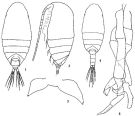 issued from: Q.-c Chen & S.-z. Zhang in Studia Marina Sinica, 1965, 7. [Pl.19, 1-5]. As Scolecithricella bradyi. Female (from E China Sea): 1, habitus (dorsal); 2, idem (lateral right side); 3, P5 (posterior). Male: 4, habitus (dorsal); 5, P5 (posterior).
|
 issued from : J. Corral Estrada in Tesis Doct., Univ. Madrid, A-129, Sec. Biologicas, 1970. [Lam.43, fig.9]. Male (from Canarias Is.): 9, P5.
|
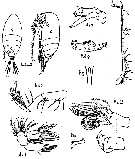 issued from : M. Rose in Annls Inst. océanogr., Monaco, 1942, XXI (3). [p.122, Figs.10, 11]. Female (from Alger Bay, Algeria): habitus (dorsal and lateral, respectively); A1; A2; Md; R, rostrum; Mx1 (as Mx); Mx2 (as Mxp1); Mxp (as Mxp2); P5. Nota: A1 19-segmented (1st and 7th segments with sketchings of fusion.
|
 issued from : M. Rose in Annls Inst. océanogr., Monaco, 1942, XXI (3). [p.123, Fig.12]. Female: Ur, urosome (ventral); P1 to P4. Nota: Genital segment asymmetrical, swollen on the left side. Caudal rami longer than wide, little divergent with 5 setae (outer seta curved, plumose from a single side; a naked bended-shape dorsal seta, about the length that outer seta). Endopodite of A2 about 3/4 exopodite.
|
 issued from : M. Rose in Annls Inst. océanogr., Monaco, 1942, XXI (3). [p.124, Figs.13, 14]. Male: habitus (lateral and dorsal, respectively); A1 (proximal portion); A2; Md; Mx1 (as Mx); Mx2 (as Mxp1); Mxp (as Mxp2); R, rostrum. Nota: Left A1 18-segmented, right side17-segmented.; Md; Mx1 (as Mx); Mx2 (as Mxp1); Mxp (as Mxp2); R, rostrum.
|
 issued from : M. Rose in Annls Inst. océanogr., Monaco, 1942, XXI (3). [p.125, Fig.15]. Male:P1 to P5. Nota: Right P5 with basipod 2 swollen; endopodite absent; exopodite 2-segmented. Left P5 with basipodite 1 and 2 very elongated; exopodite 3-segmented, the distal pointed; endopodite 1-segmented, nail-shape with a row of fine spinules.
|
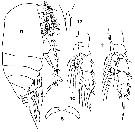 issued from : T. Mori in The pelagic Copepoda from the neighbouring waters of Japan, 1937 (2nd edit., 1964). [Pl.25, Figs.8-12]. As Scolecithricella bradyi. Female (near Hachijo Island): 8, P5; 9, habitus (lateral); 10, P2 (posterior); 11, P3 (posterior); 12, rostrum. Nota Female: - Thoracic segments 4 and 5 obscurely separated. - Posterolateral corners of the last thoracic segment asymmetrical and produced but not pointed; right side more prominent than the left and extends beyond the end of genital segment. - Genital segment asymmetrical, about as long as the combined length of the 3 following segments. - Anal segment as long as the preceeding segment. P5 very small; each foot consists of lamelliform 1-segmented appendage.
|
 issued from : C.O. Esterly in Univ. Calif. Publs Zool., 1905, 2 (4). [p.165, Fig.27]. Female (from San Diego Region): a, habitus (lateral). Line of separation between 4th and 5th thoracic segment visible only on the back; lateral portions of last thoracic segment elongated into two flaps, on the right more than on the left. Caudal rami twice as long as broad. A1 19-segmented, not reaching the posterior end of the thorax. Exopod of A2 longer than the endopod. Exopod of Mx1 with 4 bristles. Male: right A1 with 18 segments, left with 17.
|
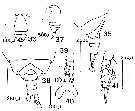 issued from : D.F.R. Arcos in Gayana, Zool., 1975, 32. [Lam.IV, Figs.35-41]. As Scolecithricella bradyi. Female (from Bahia de Concepcion, Chile): 35, posterior part of cephalothorax and urosome (lateral); 36-37, habitus (dorsal and lateral, respectively); 38, posterior part of cephalothorax and urosome (dorsal); 39, P1; 40, P5; 41, P2.
|
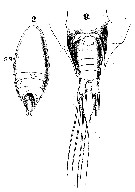 Issued from : W. Giesbrecht in Systematik und Faunistik der Pelagischen Copepoden des Golfes von Neapel und der angrenzenden Meeres-Abschnitte. – Fauna Flora Golf. Neapel, 1892. Atlas von 54 Tafeln. [Taf.37 , Figs.2, 9 ]. Female: 2, habitus (dorsal); 9, last thoracic segment with P5 and urosome (ventral).
|
 Issued from : W. Giesbrecht in Systematik und Faunistik der Pelagischen Copepoden des Golfes von Neapel und der angrenzenden Meeres-Abschnitte. – Fauna Flora Golf. Neapel, 1892. Atlas von 54 Tafeln. [Taf. 13, Fig.21]. Female: 21, A1 (dorsal view).
|
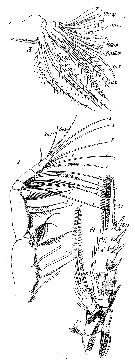 Issued from : W. Giesbrecht in Systematik und Faunistik der Pelagischen Copepoden des Golfes von Neapel und der angrenzenden Meeres-Abschnitte. – Fauna Flora Golf. Neapel, 1892. Atlas von 54 Tafeln. [Taf. 13, Figs.3, 7, 11]. Female: 3, Mx2 (posterior view); 7, Mxp (anterior view); 11, P2 (posterior view).
|
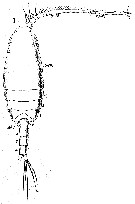 Issued from : W. Giesbrecht in Systematik und Faunistik der Pelagischen Copepoden des Golfes von Neapel und der angrenzenden Meeres-Abschnitte. – Fauna Flora Golf. Neapel, 1892. Atlas von 54 Tafeln. [Taf. 37, Fig.1]. Male: habitus (dorsal).
|
 Issued from : W. Giesbrecht in Systematik und Faunistik der Pelagischen Copepoden des Golfes von Neapel und der angrenzenden Meeres-Abschnitte. – Fauna Flora Golf. Neapel, 1892. Atlas von 54 Tafeln. [Taf. 13, Fig.1]. Male: 1, left A1 (dorsal view).
|
 Issued from : W. Giesbrecht in Systematik und Faunistik der Pelagischen Copepoden des Golfes von Neapel und der angrenzenden Meeres-Abschnitte. – Fauna Flora Golf. Neapel, 1892. Atlas von 54 Tafeln. [Taf. 13, Fig.28]. male: 28, P5 (anterior view).
|
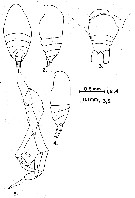 issued from : G.D. Grice in Fish. Bull. Fish and Wildl. Ser., 1962, 61. [p.207, Pl.16, Figs.1-5]. Female (from equatorial Pacific): 1-2, habitus (dorsal and lateral, respectively); 3, posterior part of thorax and urosome (ventral). Male: 4, habitus (lateral); 5, P5.
|
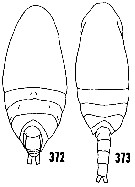 issued from : H.B. Owre & M. Foyo in Fauna Caribaea, 1967, 1, Crustacea, 1: Copepoda. [p.59, Figs.372-373]. After Giesbrecht (1892). Female (from Florida Current): 372, habitus (dorsal). Nota: A1 not extending past the metasome. Male: 373, habitus (dorsal).
|
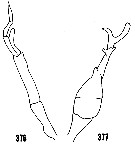 issued from : H.B. Owre & M. Foyo in Fauna Caribaea, 1967, 1, Crustacea, 1: Copepoda. [p.59, Fig.376-377]. After Giesbrecht (1892). Male: 376, left P5; 377, right P5. Nota: One side of P5 somewhat longer than the other.
|
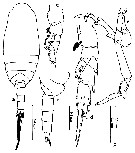 issued from : Mulyadi in Published by Res. Center Biol., Indonesia Inst. Sci. Bogor, 2004. [p.39, Fig.20]. Male (from Flores Sea): a, habitus (dorsal); b, urosome (lateral right side); c, P1; d, P4; e, P5.
|
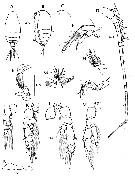 Issued from : H.Y. Soh, S.Y. Moon & J.H. Wi in Invertebrate Fauna of Korea (eds) Incheon: NIBR, 2013, 21 (28). [p.87, Fig.49]. Female (from Korean waters): A-B, habitus (dorsal and lateral, respectively); C, forehead (lateral); D, A1; E, A2; F, Md; G, Mx1; H, Mx2; I, mxp; J, P1; K, P2; L, P3; M, P4; N, P5. Scale bars: A-C = 500 µm; D-M = 200 µm; N = 50 µm.
|
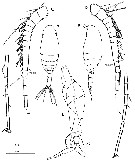 Issued from : H.Y. Soh, S.Y. Moon & J.H. Wi in Invertebrate Fauna of Korea (eds) Incheon: NIBR, 2013, 21 (28). [p.88, Fig.50]. Male: A-B, habitus (dorsal and lateral, respectively); C-D, A1; E, P5. Scale bars: A, B = 300 µm; C-E = 20 µm.
|
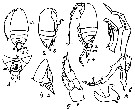 Issued from : M.C. Kos in Field guide for plankton. Zool Institute USSR Acad., Vol. I, 1972. After Brodsky, 1962. Female: 1-2, habitus (dorsal and lateral, respectively); 3-4, last thoracic segment and abdomen (ventral); 4, same (lateral); 5, P1. 6, P5, 7, Habitus (lateral).
| | | | | Ref. compl.: | | | Rose, 1924, p.5, 7, 8, 10); 1925 (p.152); V.N. Greze, 1963 a (tabl.2, comme brady); Shmeleva, 1963 (p.141); Gaudy, 1963 (p.24, Rem.); Unterüberbacher, 1964 (p.25); De Decker & Mombeck, 1964 (p.14); Grice & Hulsemann, 1965 (p.224); Shmeleva, 1965 b (p.1350, lengths-volume -weight relation); Mazza, 1966 (p.71); Pavlova, 1966 (p.43); Grice & Hulsemann, 1967 (p.17); Fleminger, 1967 a (tabl.1); Berdugo & Kimor, 1968 (p.448); De Decker, 1968 (p.45); Vinogradov, 1968 (1970) (p.78); Park, 1970 (p.476); Deevey, 1971 (p.224); Timonin, 1971 (p.281, trophic group); Brodsky, 1972 (p.256); Bainbridge, 1972 (p.61, Appendix Table I: vertical distribution vs day/night, Table II: %); Binet & al., 1972 (p.69); Apostolopoulou, 1972 (p.327, 350); Roe, 1972 (p.277, tabl.1, tabl.2); 1972 b (p.541); Heinrich, 1973 (p.95); Björnberg, 1973 (p.331, 389); Corral Estrada & Pereiro Muñoz, 1974 (tab.I); Deevey & Brooks, 1977 (p.256, tab.2, Station "S"); Carter, 1977 (1978) (p.36); Dessier, 1979 (p.205); Hayward, 1980 (p.295, Table 2, vertical distribution, feeding); Vaissière & Séguin, 1980 (p.23, tab.2); Vives, 1982 (p.292); Gaudy & Boucker, 1983 (p.37, Table 1, 2, 3, 5, fig.12, Rem.: metabolism); Dessier, 1983 (p.89, Tableau 1, Rem., %); Tremblay & Anderson, 1984 (p.6, Rem.); De Decker, 1984 (p.316); Brenning, 1984 (p.7, Rem.); Scotto di Carlo & al., 1984 (p.1042); Cummings, 1984 (p.163, Table 2); Regner, 1985 (p.11, Rem.: p.31); Petipa & Borichenko, 1985 (tab.2); Longhurst, 1985 (tab.2); Brenning, 1985 a (p.28, Table 2); Brinton & al., 1986 (p.228, Table 1); Chen Y.-Q., 1986 (p.205, Table 1: abundance %, Table 2: vertical distribution); Madhupratap & Haridas, 1986 (p.105, tab.1); Ambler & Miller, 1987 (tab.2, 3, 4, 5); Jimenez-Perez & Lara-Lara, 1988; Lozano Soldevilla & al., 1988 (p.59); Lopez Ibarra, 2008 (p.1, Table 1, figs.11: abundance); Cervantes-Duarte & Hernandez-Trujillo, 1989 (tab.3); Suarez & al., 1990 (tab.2); Suarez & Gasca, 1991 (tab.2); Hernandez-Trujillo, 1991 (1993) (tab.I); Suarez, 1992 (App.1); Seguin & al., 1993 (p.23); Palomares Garcia & Vera, 1995 (tab.1); Jamet & Ferec-Corbel, 1996 (p.17, tab.1); Suarez-Morales & Gasca, 1997 (p.1525); Hure & Krsinic, 1998 (p.101); Gilabert & Moreno, 1998 (tab.1, 2); Alvarez-Cadena & al., 1998 (tab.1,2,3,4); Suarez-Morales, 1998 (p.345, Table 1); Suarez-Morales & Gasca, 1998 a (p.111); Siokou-Frangou, 1999 (p.476); Onishchik, 1999 (p.76); Fernandez-Alamo & al., 2000 (p.1139, Appendix); Suarez-Morales & al., 2000 (p.751, tab.1); Seridji & Hafferssas, 2000 (tab.1); Lopez-Salgado & al., 2000 (tab.1); Lapernat & Razouls, 2001 (p.123, tab.1); Haury & al., 2000 (p.69, Table 1); Holmes, 2001 (p.60); Beaugrand & al., 2002 (p.179, figs.5, 6); Vukanic, 2003 (139, tab.1); Hsiao & al., 2004 (p.326, tab.1); Gallienne & al., 2004 (p.5, tab.3); Lo & al., 2004 (p.89, tab.1); Vukanic & Vukanic, 2004 (p.9, tab. 3); Isari & al., 2006 (p.241, tab.II); Hwang & al., 2006 (p.943, tabl.I); Lopez-Ibarra & Palomares-Garcia, 2006 (p.63, Tabl. 1, seasonal abundance vs El-Niño); Lavaniegos & Jiménez-Pérez, 2006 (p.156, tab.2, 3, Rem.); Kuriyama & Nishida, 2006 (p.293, 300: Tab.II, fig.7, 10, vertical distribution); Valdés & al., 2007 (p.104: tab.1); Khelifi-Touhami & al., 2007 (p.327, Table 1); Dur & al., 2007 (p.197, Table IV); Neumann-Leitao & al., 2008 (p.799: Tab.II, fig.6); Morales-Ramirez & Suarez-Morales, 2008 (p.522); Selifonova & al., 2008 (p.305, Tabl. 2); Fernandes, 2008 (p.465, Tabl.2); Raybaud & al., 2008 (p.1765, Table A1); C.-Y. Lee & al., 2009 (p.151, Tab.2); Skovgaard & Salomonsen, 2009 (p.425, Table 2); Escribano & al., 2009 (p.1083, Table 1, figs.6, 10); C.E. Morales & al., 2010 (p.158, Table 1); Williamson & McGowan, 2010 (p.273, Table III, Pacific central gyres: N & S); Schnack-Schiel & al., 2010 (p.2064, Table 2: E Atlantic subtropical/tropical); Hidalgo & al., 2010 (p.2089, fig.4, Table 2, cluster analysis); Mazzocchi & Di Capua, 2010 (p.427); Medellin-Mora & Navas S., 2010 (p.265, Tab. 2); Hsiao S.H. & al., 2011 (p.475, Appendix I); Hsiao & al., 2011 (p.317, Table 2, indicator of seasonal change); Guo & al., 2011 (p.567, table 2, indicator); Tseng L.-C. & al., 2011 (p.47, Table 2, occurrences vs mesh sizes); Tutasi & al., 2011 (p.791, Table 2, abundance distribution vs La Niña event); Uysal & Shmeleva, 2012 (p.909, Table I); Miloslavic & al., 2012 (p.165, Table 2, transect distribution); Salah S. & al., 2012 (p.155, Tableau 1); Jang M.-C & al., 2012 (p.37, abundance and seasonal distribution); Hidalgo & al., 2012 (p.134, Table 2) ; Gubanova & al., 2013 (in press, p.4, Table 2); Palomares-Garcia & al., 2013 (p.1009, Table I, abundance vs environmental factors); Lidvanov & al., 2013 (p.290, Table 2, % composition); Hwang & al., 2014 (p.43, Appendix A: seasonal abundance); Bonecker & a., 2014 (p.445, Table II: frequency, horizontal & vertical distributions); Mazzocchi & al., 2014 (p.64, Table 5, abundance); Zaafa & al., 2014 (p.67, Table I, occurrence); Fierro Gonzalvez, 2014 (p.1, Tab. 3, 5, occurrence, abundance); Zakaria & al., 2016 (p.1, Table 1); Benedetti & al., 2016 (p.159, Table I, fig.1, functional characters); El Arraj & al., 2017 (p.272, table 2); Benedetti & al., 2018 (p.1, Fig.2: ecological functional group); Belmonte, 2018 (p.273, Table I: Italian zones); Chaouadi & Hafferssas, 2018 (p.913, Table II: occurrence); Dias & al., 2019 (p.1, Table II, IV, occurrrence, vertical distribution). | | | | NZ: | 19 | | |
|
Carte de distribution de Scolecithrix bradyi par zones géographiques
|
| | | | | | | | | | | | 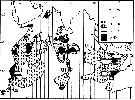 issued from : Gopalakrishnan & Saraledevi in Pelagic Biogeography ICoPB II. Proc. 2nd Int. Conf. Final report of SCOR/IOC working group 93. 9-14 July 1995. Workshop Rep. No.142. UNESCO, 1998. [p.129, Fig.2]. issued from : Gopalakrishnan & Saraledevi in Pelagic Biogeography ICoPB II. Proc. 2nd Int. Conf. Final report of SCOR/IOC working group 93. 9-14 July 1995. Workshop Rep. No.142. UNESCO, 1998. [p.129, Fig.2].
Distribution and abundance of specimens/standard/haul of Scolecithricella bradyi (= Scolecithrix bradyi) in the Indian Ocean. |
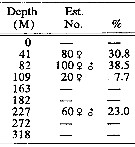 issued from : H.B. Owre & M. Foyo in Fauna Caribaea, 1967, 1, Crustacea, 1: Copepoda. [p.59, Table 23]. issued from : H.B. Owre & M. Foyo in Fauna Caribaea, 1967, 1, Crustacea, 1: Copepoda. [p.59, Table 23].
Vertical distribution of Scolecithrix bradyi in the Florida Current (SL 53 station, B 1-9).
Nota: This distribution suggests an upward migration at night. |
 issued from : A.A. Shmeleva in Bull. Inst. Oceanogr., Monaco, 1965, 65 (n°1351). [Table 6: 21 ]. Scolecithrix bradyi (from South Adriatic). issued from : A.A. Shmeleva in Bull. Inst. Oceanogr., Monaco, 1965, 65 (n°1351). [Table 6: 21 ]. Scolecithrix bradyi (from South Adriatic).
Dimensions, volume and Weight wet. Means for 50-60 specimens. Volume and weight calculated by geometrical method. Assumed that the specific gravity of the Copepod body is equal to 1, then the volume will correspond to the weight. |
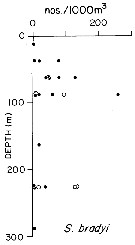 issued from : T.L. Hayward in Mar. Biol., 1980, 58. [p.299, Fig.2]. issued from : T.L. Hayward in Mar. Biol., 1980, 58. [p.299, Fig.2].
Plots of day (open circle) and night (filled circle) depth distributions of Scolecithrix bradyi in the North Pacific central gyre (main sampling location: 25°N, 155°W with drogue), September 1968. |
| | | | Loc: | | | South Africa (E & W), Namibia, Angola, Congo, off N St. Helena Is., off Ascension Is., G. of Guinea, Ivorian shelf, off S Cape Verde Is., off S Senegal-Mauritania, Canary Is., Morocco-Mauritania, Cap Ghir (Morocco), off Madeira, Brazil, off Rio de Janeiro, The Campos Basin, off Amazon, Barbados Is., Caribbean Sea, Caribbean Colombia, Yucatan, G. of Mexico, Cuba, Florida, Sargasso Sea, off Bermuda: Station ‘’ S’’ (32°10’N, 64°30’W), off Azores, off E Nova Scotia, G. of St. Lawrence, off E Newfoundland, Flemish Cape, off W Ireland, Iberian Shelf, Portugal, Medit. (M'Diq, Alboran Sea, Habibas Is., Sidi Fredj coast, Algiers, Gulf of Annaba, Marseille, Monaco,Ligurian Sea, Tyrrhenian Sea, Strait of Messina, off Malta, Adriatic Sea, Ionian Sea, Aegean Sea, W Egyptian coast, Lebanon Basin, W Black Sea), Indian, Natal, Madagascar (Nosy Bé), Mascarene Basin, Rodrigues Is. - Seychelles, Bay of Bengal, Indonesia-Malaysia, Flores Sea, Philippines, Gulf of Tonkin, China Seas (Yellow Sea, East China Sea, Taiwan Strait, South China Sea), Taiwan ( SW, Kuroshio Current, Mienhua Canyon, NW, NE), S Korea, Korea Strait, Japan Sea, Japan, Sagami Bay, Kuchinoerabu Is., Kuroshio zone, Bering Sea, N Pacific (central gyre), W Pacif. (equatorial), Australia (Great Barrier), New Zealand, Hawaii, off Hawaii NE, California, W Baja California, Bahia Magdalena, Gulf of California, W Mexico, G. of Tehuantepec, off W Guatemala, W Costa Rica, Pacif. (equatorial), Pacific (central gyres: N & S), W Central America, off SW Galapagos, S Pacific (NPFZ), Galapagos-Ecuador, Peru, Chile (N-S, off Santiago, Concepcion) | | | | N: | 231 | | | | Lg.: | | | (9) F: 1,25-1,2; M: 1,3; (16) F: 1,15; M: 1,4; (34) F: 1,2-1,08; M: 1; (47) F: 1,3-1,1; M: 1,42-1,35; (54) F: 1,21; (72) F: 1,4-1,22; M: 1,51; (75) F: 1,39; (101) F: 1,41-1,33; M: 1,56; 1,51; (117) F: 1,39; M: 1,48; (142) F: 1,4; (150) F: 1,36-1,17; M: 1,42; (180) F: 1,3-1,1; M: 1,4-1,38; (199) F: 1,29-1,22; M: 1,52-1,37; (290) F: 1,25-1,35; M: 1,3-1,35; (327) M: 1,42; (340) F: 1,2; (432) F: 1,3; (449) F: 1,3-1,1; M: 1,42-1,35; (991) F: 1,1-1,61; M: 1,3-1,56; (1000) F: 1,3 ± 0.0; (1111) F: 1,2; 1,3; (1122) M: 1,3; (1174) F: 1,14-1,17; M: 1,09-1,12; (1230) F: 1,1-1,4; M: 1,3-1,5; {F: 1,08-1,61; M: 1,00-1,56} | | | | Rem.: | épipélagique. (off Malte: depth sample: 1500 m).
Voir aussi les remarques en anglais | | | Dernière mise à jour : 25/10/2022 | |
|
|
 Toute utilisation de ce site pour une publication sera mentionnée avec la référence suivante : Toute utilisation de ce site pour une publication sera mentionnée avec la référence suivante :
Razouls C., Desreumaux N., Kouwenberg J. et de Bovée F., 2005-2025. - Biodiversité des Copépodes planctoniques marins (morphologie, répartition géographique et données biologiques). Sorbonne Université, CNRS. Disponible sur http://copepodes.obs-banyuls.fr [Accédé le 03 décembre 2025] © copyright 2005-2025 Sorbonne Université, CNRS
|
|
 |
 |




























